service JEEP WRANGLER UNLIMITED 2020 Owner handbook (in English)
[x] Cancel search | Manufacturer: JEEP, Model Year: 2020, Model line: WRANGLER UNLIMITED, Model: JEEP WRANGLER UNLIMITED 2020Pages: 330, PDF Size: 9.16 MB
Page 68 of 330
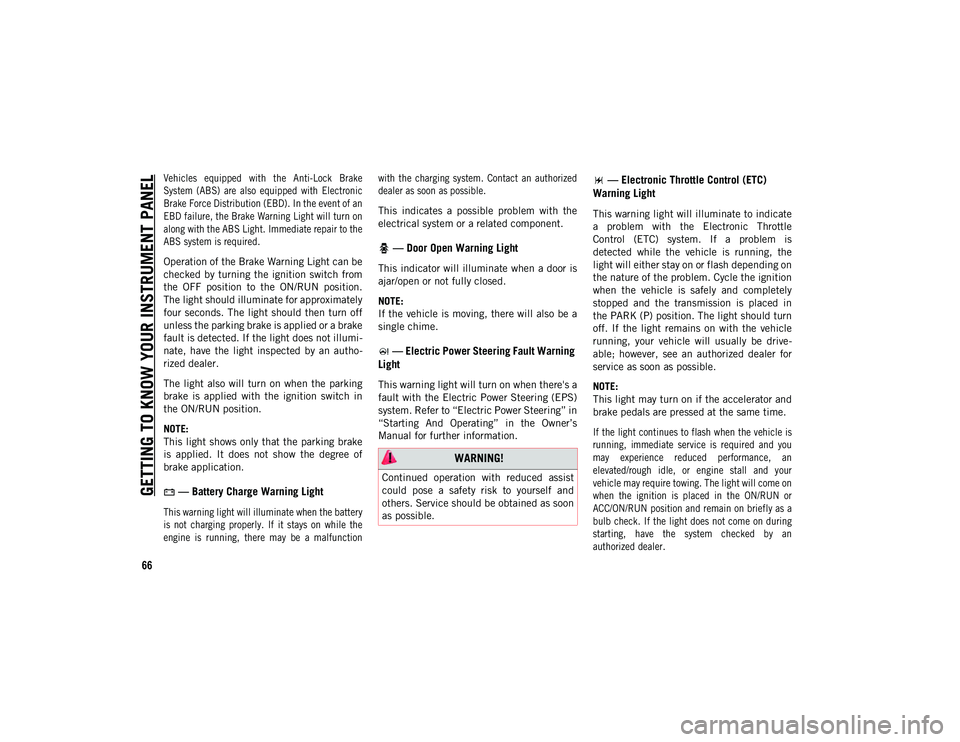
GETTING TO KNOW YOUR INSTRUMENT PANEL
66
Vehicles equipped with the Anti-Lock Brake
System (ABS) are also equipped with Electronic
Brake Force Distribution (EBD). In the event of an
EBD failure, the Brake Warning Light will turn on
along with the ABS Light. Immediate repair to the
ABS system is required.
Operation of the Brake Warning Light can be
checked by turning the ignition switch from
the OFF position to the ON/RUN position.
The light should illuminate for approximately
four seconds. The light should then turn off
unless the parking brake is applied or a brake
fault is detected. If the light does not illumi-
nate, have the light inspected by an autho -
rized dealer.
The light also will turn on when the parking
brake is applied with the ignition switch in
the ON/RUN position.
NOTE:
This light shows only that the parking brake
is applied. It does not show the degree of
brake application.
— Battery Charge Warning Light
This warning light will illuminate when the battery
is not charging properly. If it stays on while the
engine is running, there may be a malfunction with the charging system. Contact an authorized
dealer as soon as possible.
This indicates a possible problem with the
electrical system or a related component.
— Door Open Warning Light
This indicator will illuminate when a door is
ajar/open or not fully closed.
NOTE:
If the vehicle is moving, there will also be a
single chime.
— Electric Power Steering Fault Warning
Light
This warning light will turn on when there's a
fault with the Electric Power Steering (EPS)
system. Refer to “Electric Power Steering” in
“Starting And Operating” in the Owner’s
Manual for further information.
— Electronic Throttle Control (ETC)
Warning Light
This warning light will illuminate to indicate
a problem with the Electronic Throttle
Control (ETC) system. If a problem is
detected while the vehicle is running, the
light will either stay on or flash depending on
the nature of the problem. Cycle the ignition
when the vehicle is safely and completely
stopped and the transmission is placed in
the PARK (P) position. The light should turn
off. If the light remains on with the vehicle
running, your vehicle will usually be drive -
able; however, see an authorized dealer for
service as soon as possible.
NOTE:
This light may turn on if the accelerator and
brake pedals are pressed at the same time.
If the light continues to flash when the vehicle is
running, immediate service is required and you
may experience reduced performance, an
elevated/rough idle, or engine stall and your
vehicle may require towing. The light will come on
when the ignition is placed in the ON/RUN or
ACC/ON/RUN position and remain on briefly as a
bulb check. If the light does not come on during
starting, have the system checked by an
authorized dealer.
WARNING!
Continued operation with reduced assist
could pose a safety risk to yourself and
others. Service should be obtained as soon
as possible.
2020_JEEP_JL_WRANGLER_UG_RHD_UK.book Page 66
Page 69 of 330
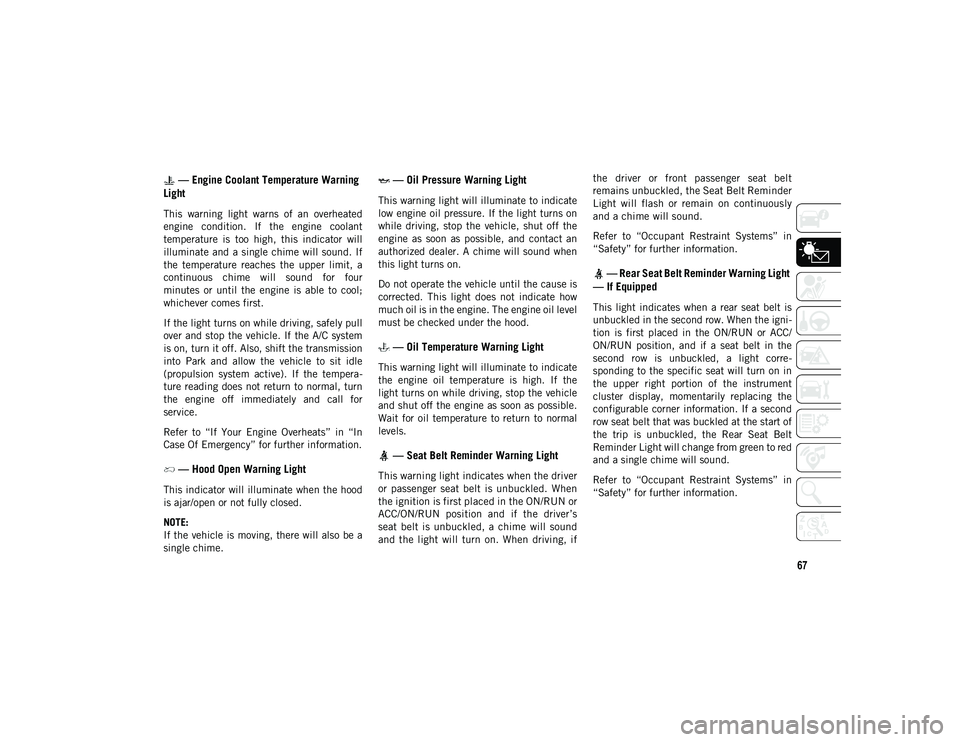
67
— Engine Coolant Temperature Warning
Light
This warning light warns of an overheated
engine condition. If the engine coolant
temperature is too high, this indicator will
illuminate and a single chime will sound. If
the temperature reaches the upper limit, a
continuous chime will sound for four
minutes or until the engine is able to cool;
whichever comes first.
If the light turns on while driving, safely pull
over and stop the vehicle. If the A/C system
is on, turn it off. Also, shift the transmission
into Park and allow the vehicle to sit idle
(propulsion system active). If the tempera -
ture reading does not return to normal, turn
the engine off immediately and call for
service.
Refer to “If Your Engine Overheats” in “In
Case Of Emergency” for further information.
— Hood Open Warning Light
This indicator will illuminate when the hood
is ajar/open or not fully closed.
NOTE:
If the vehicle is moving, there will also be a
single chime.
— Oil Pressure Warning Light
This warning light will illuminate to indicate
low engine oil pressure. If the light turns on
while driving, stop the vehicle, shut off the
engine as soon as possible, and contact an
authorized dealer. A chime will sound when
this light turns on.
Do not operate the vehicle until the cause is
corrected. This light does not indicate how
much oil is in the engine. The engine oil level
must be checked under the hood.
— Oil Temperature Warning Light
This warning light will illuminate to indicate
the engine oil temperature is high. If the
light turns on while driving, stop the vehicle
and shut off the engine as soon as possible.
Wait for oil temperature to return to normal
levels.
— Seat Belt Reminder Warning Light
This warning light indicates when the driver
or passenger seat belt is unbuckled. When
the ignition is first placed in the ON/RUN or
ACC/ON/RUN position and if the driver’s
seat belt is unbuckled, a chime will sound
and the light will turn on. When driving, if the driver or front passenger seat belt
remains unbuckled, the Seat Belt Reminder
Light will flash or remain on continuously
and a chime will sound.
Refer to “Occupant Restraint Systems” in
“Safety” for further information.
— Rear Seat Belt Reminder Warning Light
— If Equipped
This light indicates when a rear seat belt is
unbuckled in the second row. When the igni -
tion is first placed in the ON/RUN or ACC/
ON/RUN position, and if a seat belt in the
second row is unbuckled, a light corre -
sponding to the specific seat will turn on in
the upper right portion of the instrument
cluster display, momentarily replacing the
configurable corner information. If a second
row seat belt that was buckled at the start of
the trip is unbuckled, the Rear Seat Belt
Reminder Light will change from green to red
and a single chime will sound.
Refer to “Occupant Restraint Systems” in
“Safety” for further information.
2020_JEEP_JL_WRANGLER_UG_RHD_UK.book Page 67
Page 70 of 330
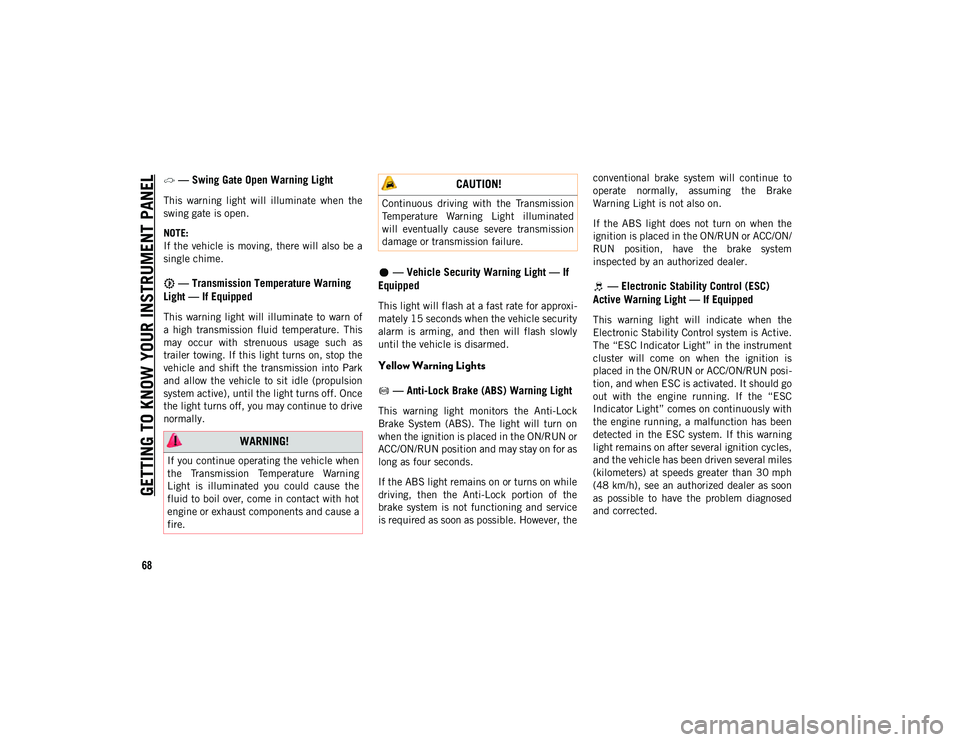
GETTING TO KNOW YOUR INSTRUMENT PANEL
68
— Swing Gate Open Warning Light
This warning light will illuminate when the
swing gate is open.
NOTE:
If the vehicle is moving, there will also be a
single chime.
— Transmission Temperature Warning
Light — If Equipped
This warning light will illuminate to warn of
a high transmission fluid temperature. This
may occur with strenuous usage such as
trailer towing. If this light turns on, stop the
vehicle and shift the transmission into Park
and allow the vehicle to sit idle (propulsion
system active), until the light turns off. Once
the light turns off, you may continue to drive
normally.
— Vehicle Security Warning Light — If
Equipped
This light will flash at a fast rate for approxi -
mately 15 seconds when the vehicle security
alarm is arming, and then will flash slowly
until the vehicle is disarmed.
Yellow Warning Lights
— Anti-Lock Brake (ABS) Warning Light
This warning light monitors the Anti-Lock
Brake System (ABS). The light will turn on
when the ignition is placed in the ON/RUN or
ACC/ON/RUN position and may stay on for as
long as four seconds.
If the ABS light remains on or turns on while
driving, then the Anti-Lock portion of the
brake system is not functioning and service
is required as soon as possible. However, the conventional brake system will continue to
operate normally, assuming the Brake
Warning Light is not also on.
If the ABS light does not turn on when the
ignition is placed in the ON/RUN or ACC/ON/
RUN position, have the brake system
inspected by an authorized dealer.
— Electronic Stability Control (ESC)
Active Warning Light — If Equipped
This warning light will indicate when the
Electronic Stability Control system is Active.
The “ESC Indicator Light” in the instrument
cluster will come on when the ignition is
placed in the ON/RUN or ACC/ON/RUN posi -
tion, and when ESC is activated. It should go
out with the engine running. If the “ESC
Indicator Light” comes on continuously with
the engine running, a malfunction has been
detected in the ESC system. If this warning
light remains on after several ignition cycles,
and the vehicle has been driven several miles
(kilometers) at speeds greater than 30 mph
(48 km/h), see an authorized dealer as soon
as possible to have the problem diagnosed
and corrected.
WARNING!
If you continue operating the vehicle when
the Transmission Temperature Warning
Light is illuminated you could cause the
fluid to boil over, come in contact with hot
engine or exhaust components and cause a
fire.
CAUTION!
Continuous driving with the Transmission
Temperature Warning Light illuminated
will eventually cause severe transmission
damage or transmission failure.
2020_JEEP_JL_WRANGLER_UG_RHD_UK.book Page 68
Page 71 of 330
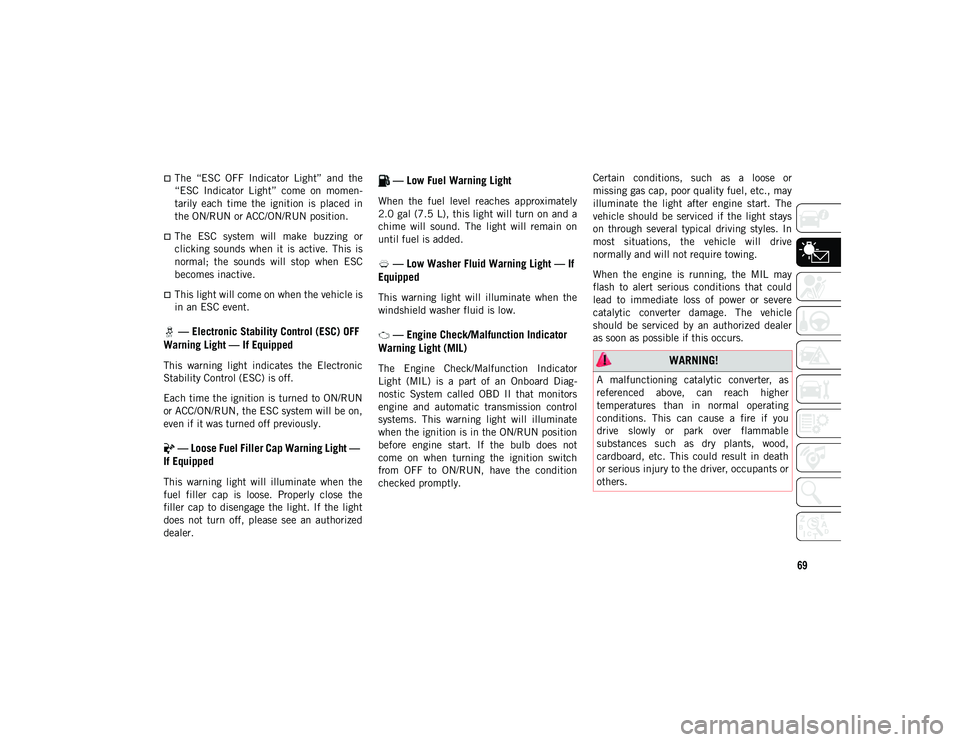
69
The “ESC OFF Indicator Light” and the
“ESC Indicator Light” come on momen-
tarily each time the ignition is placed in
the ON/RUN or ACC/ON/RUN position.
The ESC system will make buzzing or
clicking sounds when it is active. This is
normal; the sounds will stop when ESC
becomes inactive.
This light will come on when the vehicle is
in an ESC event.
— Electronic Stability Control (ESC) OFF
Warning Light — If Equipped
This warning light indicates the Electronic
Stability Control (ESC) is off.
Each time the ignition is turned to ON/RUN
or ACC/ON/RUN, the ESC system will be on,
even if it was turned off previously.
— Loose Fuel Filler Cap Warning Light —
If Equipped
This warning light will illuminate when the
fuel filler cap is loose. Properly close the
filler cap to disengage the light. If the light
does not turn off, please see an authorized
dealer.
— Low Fuel Warning Light
When the fuel level reaches approximately
2.0 gal (7.5 L), this light will turn on and a
chime will sound. The light will remain on
until fuel is added.
— Low Washer Fluid Warning Light — If
Equipped
This warning light will illuminate when the
windshield washer fluid is low.
— Engine Check/Malfunction Indicator
Warning Light (MIL)
The Engine Check/Malfunction Indicator
Light (MIL) is a part of an Onboard Diag -
nostic System called OBD II that monitors
engine and automatic transmission control
systems. This warning light will illuminate
when the ignition is in the ON/RUN position
before engine start. If the bulb does not
come on when turning the ignition switch
from OFF to ON/RUN, have the condition
checked promptly. Certain conditions, such as a loose or
missing gas cap, poor quality fuel, etc., may
illuminate the light after engine start. The
vehicle should be serviced if the light stays
on through several typical driving styles. In
most situations, the vehicle will drive
normally and will not require towing.
When the engine is running, the MIL may
flash to alert serious conditions that could
lead to immediate loss of power or severe
catalytic converter damage. The vehicle
should be serviced by an authorized dealer
as soon as possible if this occurs. WARNING!
A malfunctioning catalytic converter, as
referenced above, can reach higher
temperatures than in normal operating
conditions. This can cause a fire if you
drive slowly or park over flammable
substances such as dry plants, wood,
cardboard, etc. This could result in death
or serious injury to the driver, occupants or
others.
2020_JEEP_JL_WRANGLER_UG_RHD_UK.book Page 69
Page 72 of 330

GETTING TO KNOW YOUR INSTRUMENT PANEL
70
— AdBlue® Injection System Failure
Warning Light — If Equipped
This warning light will illuminate along with
a dedicated message on the display (If
Equipped) if an unknown fluid not
conforming with acceptable characteristics
is inserted, or if an average consumption of
AdBlue® over 50% is detected. Contact an
authorized dealer as soon as possible.
If the problem is not solved, a specific
message will appear on the Instrument
Cluster Display whenever a certain threshold
is reached until it will no longer be possible
to start the engine. When about 125 miles (200 km) are
remaining before the AdBlue® tank is
empty, a continuous dedicated message will
appear on the instrument panel, accompa
-
nied by a buzzer sound (If Equipped).
— Service 4WD Warning Light — If
Equipped
This warning light will illuminate to signal a
fault with the 4WD system. If the light stays on
or comes on during driving, it means that the
4WD system is not functioning properly and
that service is required. It is recommended you
drive to the nearest service center and have the
vehicle serviced immediately.
— Service Forward Collision Warning
(FCW) Light — If Equipped
This warning light will illuminate to indicate
a fault in the Forward Collision Warning
System. Contact an authorized dealer for
service.
Refer to "Forward Collision Warning (FCW)"
in "Safety" for further information.
— Service Stop/Start System Warning
Light — If Equipped
This warning light will illuminate when the
Stop/Start system is not functioning properly
and service is required. Contact an autho -
rized dealer for service.
— Speed Control Fault Warning Light
This warning light will illuminate to indicate
the Speed Control System is not functioning
properly and service is required. Contact an
authorized dealer.
— Sway Bar Fault Warning Light
This light will illuminate when there is a fault
in the sway bar disconnect system.
— Tire Pressure Monitoring System
(TPMS) Warning Light
The warning light switches on and a message
is displayed to indicate that the tire pressure
is lower than the recommended value and/or
that slow pressure loss is occurring. In these
cases, optimal tire duration and fuel
consumption may not be guaranteed.
CAUTION!
Prolonged driving with the Malfunction
Indicator Light (MIL) on could cause
damage to the vehicle control system. It
also could affect fuel economy and
driveability. If the MIL is flashing, severe
catalytic converter damage and power loss
will soon occur. Immediate service is
required.
2020_JEEP_JL_WRANGLER_UG_RHD_UK.book Page 70
Page 74 of 330
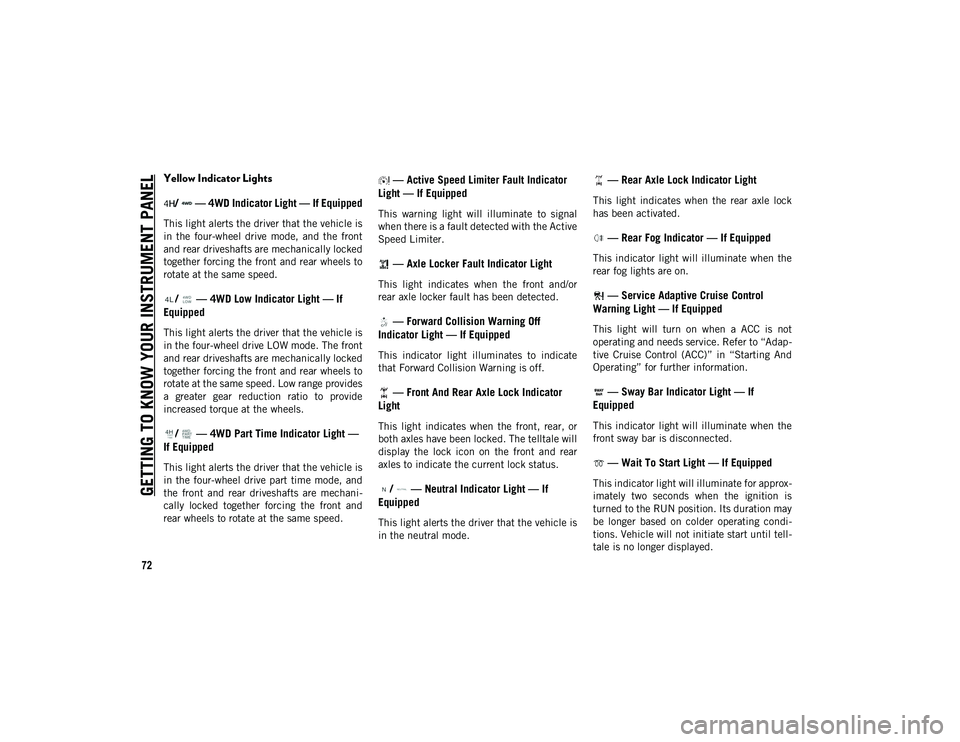
GETTING TO KNOW YOUR INSTRUMENT PANEL
72
Yellow Indicator Lights/ — 4WD Indicator Light — If Equipped
This light alerts the driver that the vehicle is
in the four-wheel drive mode, and the front
and rear driveshafts are mechanically locked
together forcing the front and rear wheels to
rotate at the same speed.
/ — 4WD Low Indicator Light — If
Equipped
This light alerts the driver that the vehicle is
in the four-wheel drive LOW mode. The front
and rear driveshafts are mechanically locked
together forcing the front and rear wheels to
rotate at the same speed. Low range provides
a greater gear reduction ratio to provide
increased torque at the wheels.
/ — 4WD Part Time Indicator Light —
If Equipped
This light alerts the driver that the vehicle is
in the four-wheel drive part time mode, and
the front and rear driveshafts are mechani -
cally locked together forcing the front and
rear wheels to rotate at the same speed.
— Active Speed Limiter Fault Indicator
Light — If Equipped
This warning light will illuminate to signal
when there is a fault detected with the Active
Speed Limiter.
— Axle Locker Fault Indicator Light
This light indicates when the front and/or
rear axle locker fault has been detected.
— Forward Collision Warning Off
Indicator Light — If Equipped
This indicator light illuminates to indicate
that Forward Collision Warning is off.
— Front And Rear Axle Lock Indicator
Light
This light indicates when the front, rear, or
both axles have been locked. The telltale will
display the lock icon on the front and rear
axles to indicate the current lock status.
/ — Neutral Indicator Light — If
Equipped
This light alerts the driver that the vehicle is
in the neutral mode.
— Rear Axle Lock Indicator Light
This light indicates when the rear axle lock
has been activated.
— Rear Fog Indicator — If Equipped
This indicator light will illuminate when the
rear fog lights are on.
— Service Adaptive Cruise Control
Warning Light — If Equipped
This light will turn on when a ACC is not
operating and needs service. Refer to “Adap -
tive Cruise Control (ACC)” in “Starting And
Operating” for further information.
— Sway Bar Indicator Light — If
Equipped
This indicator light will illuminate when the
front sway bar is disconnected.
— Wait To Start Light — If Equipped
This indicator light will illuminate for approx -
imately two seconds when the ignition is
turned to the RUN position. Its duration may
be longer based on colder operating condi -
tions. Vehicle will not initiate start until tell -
tale is no longer displayed.
2020_JEEP_JL_WRANGLER_UG_RHD_UK.book Page 72
Page 79 of 330
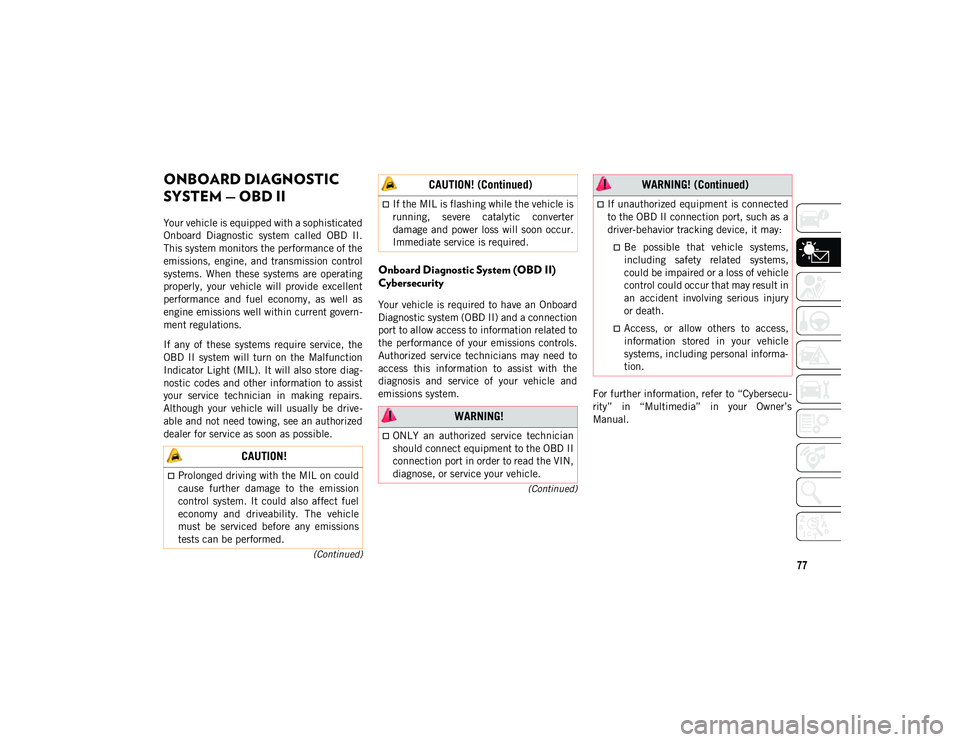
77
(Continued)
(Continued)
ONBOARD DIAGNOSTIC
SYSTEM — OBD II
Your vehicle is equipped with a sophisticated
Onboard Diagnostic system called OBD II.
This system monitors the performance of the
emissions, engine, and transmission control
systems. When these systems are operating
properly, your vehicle will provide excellent
performance and fuel economy, as well as
engine emissions well within current govern -
ment regulations.
If any of these systems require service, the
OBD II system will turn on the Malfunction
Indicator Light (MIL). It will also store diag -
nostic codes and other information to assist
your service technician in making repairs.
Although your vehicle will usually be drive -
able and not need towing, see an authorized
dealer for service as soon as possible.
Onboard Diagnostic System (OBD II)
Cybersecurity
Your vehicle is required to have an Onboard
Diagnostic system (OBD II) and a connection
port to allow access to information related to
the performance of your emissions controls.
Authorized service technicians may need to
access this information to assist with the
diagnosis and service of your vehicle and
emissions system. For further information, refer to “Cybersecu-
rity” in “Multimedia” in your Owner’s
Manual.
CAUTION!
Prolonged driving with the MIL on could
cause further damage to the emission
control system. It could also affect fuel
economy and driveability. The vehicle
must be serviced before any emissions
tests can be performed.
If the MIL is flashing while the vehicle is
running, severe catalytic converter
damage and power loss will soon occur.
Immediate service is required.
WARNING!
ONLY an authorized service technician
should connect equipment to the OBD II
connection port in order to read the VIN,
diagnose, or service your vehicle.
CAUTION! (Continued)
If unauthorized equipment is connected
to the OBD II connection port, such as a
driver-behavior tracking device, it may:
Be possible that vehicle systems, including safety related systems,could be impaired or a loss of vehicle
control could occur that may result in
an accident involving serious injury
or death.
Access, or allow others to access, information stored in your vehicle
systems, including personal informa-
tion.
WARNING! (Continued)
2020_JEEP_JL_WRANGLER_UG_RHD_UK.book Page 77
Page 81 of 330
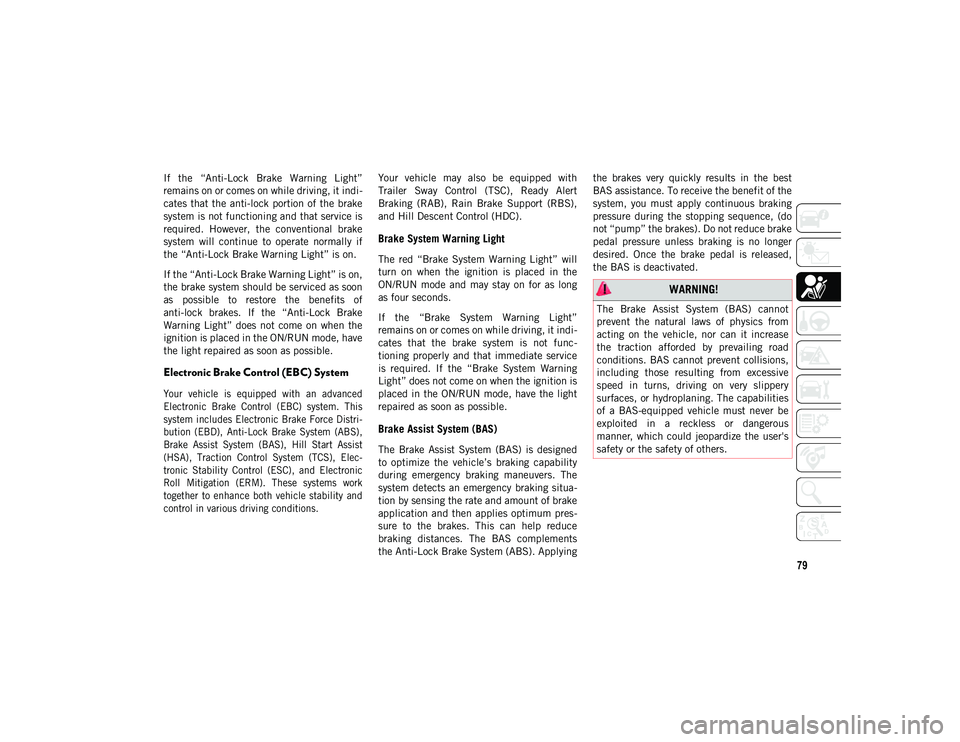
79
If the “Anti-Lock Brake Warning Light”
remains on or comes on while driving, it indi-
cates that the anti-lock portion of the brake
system is not functioning and that service is
required. However, the conventional brake
system will continue to operate normally if
the “Anti-Lock Brake Warning Light” is on.
If the “Anti-Lock Brake Warning Light” is on,
the brake system should be serviced as soon
as possible to restore the benefits of
anti-lock brakes. If the “Anti-Lock Brake
Warning Light” does not come on when the
ignition is placed in the ON/RUN mode, have
the light repaired as soon as possible.
Electronic Brake Control (EBC) System
Your vehicle is equipped with an advanced
Electronic Brake Control (EBC) system. This
system includes Electronic Brake Force Distri -
bution (EBD), Anti-Lock Brake System (ABS),
Brake Assist System (BAS), Hill Start Assist
(HSA), Traction Control System (TCS), Elec-
tronic Stability Control (ESC), and Electronic
Roll Mitigation (ERM). These systems work
together to enhance both vehicle stability and
control in various driving conditions.
Your vehicle may also be equipped with
Trailer Sway Control (TSC), Ready Alert
Braking (RAB), Rain Brake Support (RBS),
and Hill Descent Control (HDC).
Brake System Warning Light
The red “Brake System Warning Light” will
turn on when the ignition is placed in the
ON/RUN mode and may stay on for as long
as four seconds.
If the “Brake System Warning Light”
remains on or comes on while driving, it indi
-
cates that the brake system is not func -
tioning properly and that immediate service
is required. If the “Brake System Warning
Light” does not come on when the ignition is
placed in the ON/RUN mode, have the light
repaired as soon as possible.
Brake Assist System (BAS)
The Brake Assist System (BAS) is designed
to optimize the vehicle’s braking capability
during emergency braking maneuvers. The
system detects an emergency braking situa -
tion by sensing the rate and amount of brake
application and then applies optimum pres -
sure to the brakes. This can help reduce
braking distances. The BAS complements
the Anti-Lock Brake System (ABS). Applying the brakes very quickly results in the best
BAS assistance. To receive the benefit of the
system, you must apply continuous braking
pressure during the stopping sequence, (do
not “pump” the brakes). Do not reduce brake
pedal pressure unless braking is no longer
desired. Once the brake pedal is released,
the BAS is deactivated.
WARNING!
The Brake Assist System (BAS) cannot
prevent the natural laws of physics from
acting on the vehicle, nor can it increase
the traction afforded by prevailing road
conditions. BAS cannot prevent collisions,
including those resulting from excessive
speed in turns, driving on very slippery
surfaces, or hydroplaning. The capabilities
of a BAS-equipped vehicle must never be
exploited in a reckless or dangerous
manner, which could jeopardize the user's
safety or the safety of others.
2020_JEEP_JL_WRANGLER_UG_RHD_UK.book Page 79
Page 90 of 330
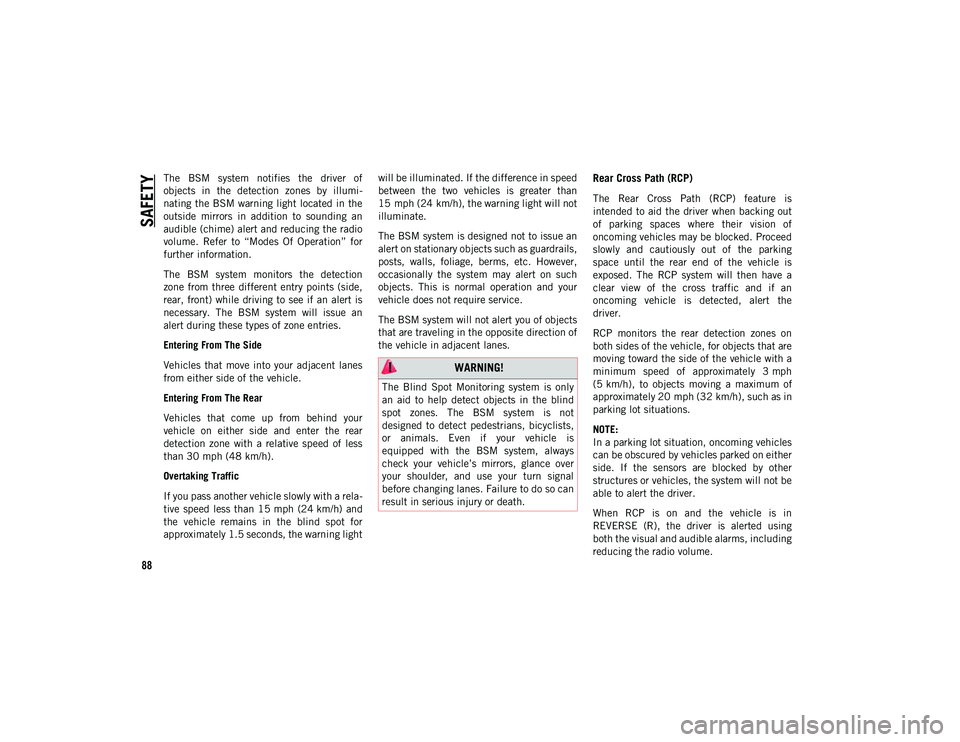
SAFETY
88
The BSM system notifies the driver of
objects in the detection zones by illumi-
nating the BSM warning light located in the
outside mirrors in addition to sounding an
audible (chime) alert and reducing the radio
volume. Refer to “Modes Of Operation” for
further information.
The BSM system monitors the detection
zone from three different entry points (side,
rear, front) while driving to see if an alert is
necessary. The BSM system will issue an
alert during these types of zone entries.
Entering From The Side
Vehicles that move into your adjacent lanes
from either side of the vehicle.
Entering From The Rear
Vehicles that come up from behind your
vehicle on either side and enter the rear
detection zone with a relative speed of less
than 30 mph (48 km/h).
Overtaking Traffic
If you pass another vehicle slowly with a rela -
tive speed less than 15 mph (24 km/h) and
the vehicle remains in the blind spot for
approximately 1.5 seconds, the warning light will be illuminated. If the difference in speed
between the two vehicles is greater than
15 mph (24 km/h), the warning light will not
illuminate.
The BSM system is designed not to issue an
alert on stationary objects such as guardrails,
posts, walls, foliage, berms, etc. However,
occasionally the system may alert on such
objects. This is normal operation and your
vehicle does not require service.
The BSM system will not alert you of objects
that are traveling in the opposite direction of
the vehicle in adjacent lanes.Rear Cross Path (RCP)
The Rear Cross Path (RCP) feature is
intended to aid the driver when backing out
of parking spaces where their vision of
oncoming vehicles may be blocked. Proceed
slowly and cautiously out of the parking
space until the rear end of the vehicle is
exposed. The RCP system will then have a
clear view of the cross traffic and if an
oncoming vehicle is detected, alert the
driver.
RCP monitors the rear detection zones on
both sides of the vehicle, for objects that are
moving toward the side of the vehicle with a
minimum speed of approximately 3 mph
(5 km/h), to objects moving a maximum of
approximately 20 mph (32 km/h), such as in
parking lot situations.
NOTE:
In a parking lot situation, oncoming vehicles
can be obscured by vehicles parked on either
side. If the sensors are blocked by other
structures or vehicles, the system will not be
able to alert the driver.
When RCP is on and the vehicle is in
REVERSE (R), the driver is alerted using
both the visual and audible alarms, including
reducing the radio volume.
WARNING!
The Blind Spot Monitoring system is only
an aid to help detect objects in the blind
spot zones. The BSM system is not
designed to detect pedestrians, bicyclists,
or animals. Even if your vehicle is
equipped with the BSM system, always
check your vehicle’s mirrors, glance over
your shoulder, and use your turn signal
before changing lanes. Failure to do so can
result in serious injury or death.
2020_JEEP_JL_WRANGLER_UG_RHD_UK.book Page 88
Page 94 of 330
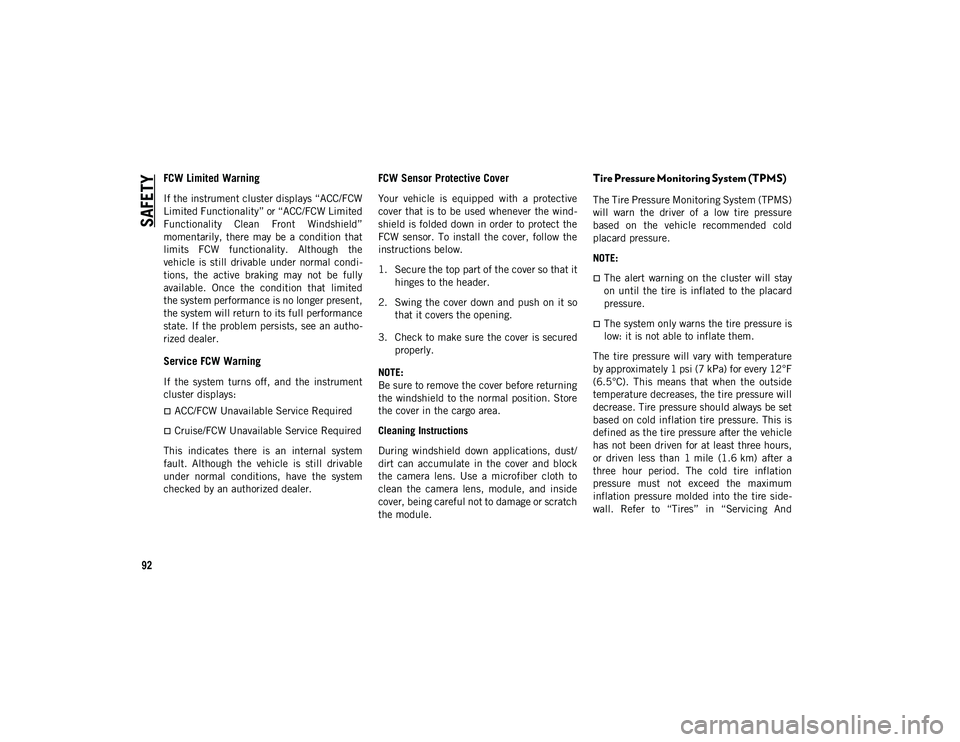
SAFETY
92
FCW Limited Warning
If the instrument cluster displays “ACC/FCW
Limited Functionality” or “ACC/FCW Limited
Functionality Clean Front Windshield”
momentarily, there may be a condition that
limits FCW functionality. Although the
vehicle is still drivable under normal condi-
tions, the active braking may not be fully
available. Once the condition that limited
the system performance is no longer present,
the system will return to its full performance
state. If the problem persists, see an autho -
rized dealer.
Service FCW Warning
If the system turns off, and the instrument
cluster displays:
ACC/FCW Unavailable Service Required
Cruise/FCW Unavailable Service Required
This indicates there is an internal system
fault. Although the vehicle is still drivable
under normal conditions, have the system
checked by an authorized dealer.
FCW Sensor Protective Cover
Your vehicle is equipped with a protective
cover that is to be used whenever the wind -
shield is folded down in order to protect the
FCW sensor. To install the cover, follow the
instructions below.
1. Secure the top part of the cover so that it hinges to the header.
2. Swing the cover down and push on it so that it covers the opening.
3. Check to make sure the cover is secured properly.
NOTE:
Be sure to remove the cover before returning
the windshield to the normal position. Store
the cover in the cargo area.
Cleaning Instructions
During windshield down applications, dust/
dirt can accumulate in the cover and block
the camera lens. Use a microfiber cloth to
clean the camera lens, module, and inside
cover, being careful not to damage or scratch
the module.
Tire Pressure Monitoring System (TPMS)
The Tire Pressure Monitoring System (TPMS)
will warn the driver of a low tire pressure
based on the vehicle recommended cold
placard pressure.
NOTE:
The alert warning on the cluster will stay
on until the tire is inflated to the placard
pressure.
The system only warns the tire pressure is
low: it is not able to inflate them.
The tire pressure will vary with temperature
by approximately 1 psi (7 kPa) for every 12°F
(6.5°C). This means that when the outside
temperature decreases, the tire pressure will
decrease. Tire pressure should always be set
based on cold inflation tire pressure. This is
defined as the tire pressure after the vehicle
has not been driven for at least three hours,
or driven less than 1 mile (1.6 km) after a
three hour period. The cold tire inflation
pressure must not exceed the maximum
inflation pressure molded into the tire side -
wall. Refer to “Tires” in “Servicing And
2020_JEEP_JL_WRANGLER_UG_RHD_UK.book Page 92